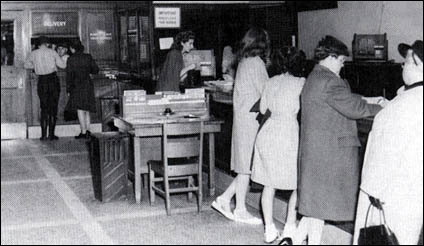Vol. 18 No. 6
June, 1988
|
Make Tomorrow Happen
|

C.P.R. Sparks Telegraph Controversy
|

Omer Lavallee
Railway
Historian
Emeritus
|

Patrons are
seen here at the corner of the Portage and Main streets office
of CP Telegraphs in Winnipeg in the 1940s.
From the time of the introduction of the electric telegraph to commercial
use in North America by Samuel F.B. Morse in 1844, telegraph operations were carried on by private companies
specially organized for the purpose.
In Canada, one of the earliest of these was the Montreal Telegraph Company, incorporated in 1847. It was the
nucleus of the Great North Western Telegraph Company (GNWC) which, in 1880, dominated the field in this
country. Its high-profile counterpart in the United States, which for a time had a controlling
interest in the GNWC, was the Western Union Telegraph Company which was founded in 1851.
When Canadian Pacific was organized in 1881, it adopted the telegraph for railway operating purposes, in line
with every other railway on the continent.
However, CPR rail lines under construction started to create and serve new communities, Erastus Wiman, the
aggressive president of the GNWC, attempted to make an arrangement with the CPR to take over and handle the
latter's commercial telegraph business.
William C. Van Horne, Canadian Pacific's general manager, had already made up his mind that specialized
operations such as telegraphs, sleeping, dining, parlor car services, and express, etc., would be operated by
the company itself.
This was contrary of usual practice elsewhere in North America, where such services were provided under
contract to the rail carrier by independent organizations: Western Union (telegraph), Pullman, Wagner
(SD&PC cars), Wells Fargo, and Adams (express) among others.
Van Horne reasoned that since commercial telegraph messages would not only be handled over wires built and
maintained by Canadian Pacific but, in most cases, be received and transmitted by the company's railway
service employees, it was simply bad business to share revenues with a separate organization.
Van Horne Infuriated by Letter
When Wiman became aware of this, he became enraged, taking out his anger in a strong letter to George Stephen,
the CPR's president, in which he stated that Van Horne "...intended to run out all other telegraph
companies..."
Van Horne was infuriated by Wiman's letter. In a memorandum to Stephen, he observed that, "I am appalled
by Mr. Wiman's impudence... (he) wanted our telegraph system for next to nothing, while I wanted full value
for it..."
He went on to say that at such time as the CPR's board was ready to discuss telegraph policy, "I shall
strongly represent the great value of their telegraph privileges... and not in any event to part with them for
less than their full value..."
General Manager's Convictions Prevail
Needless to say, Van Horne's convictions prevailed. The CPR began to accept, transmit, and deliver commercial
messages on its own account in August, 1883.
His lead in this policy was eventually adopted by other systems in this country, notably the Canadian Northern
Railway, which incorporated its own telegraph company in 1902. It, along with the GNWC, eventually became a
component of Canadian National Telegraphs. After operating in competition in Canada for more than half a
century, the CN and CP operations were merged, a decade ago, into CNCP Telecommunications.
As to the technology of transmission, various designs of printing telegraph instruments were patented in the
U.S. as early as the 1840s, just a few years after Morse's application. However, they were complicated and
unreliable; the "Morse" telegraph operator remained the undisputed master of wire communications
until the First World War era, when the first reliable teletype machines were introduced on busy interurban
wires in the U.S. Such use was extended to Canada in the 1920s.
Inevitably, these machines became faster and more efficient as technology advanced, ultimately ousting the
traditional telegraph from the scene. Since the 1960s, expanding availability of installed telecommunications
equipment for business use has made redundant the "store-front" local communications
office, which was referred to in last month's column.
We'll conclude this topic next month.
This Canadian Pacific
Railway News article is copyright 1988 by the Canadian Pacific Railway and is reprinted here
with their permission. All photographs, logos, and trademarks are the property of the Canadian Pacific Railway
Company.
|
|